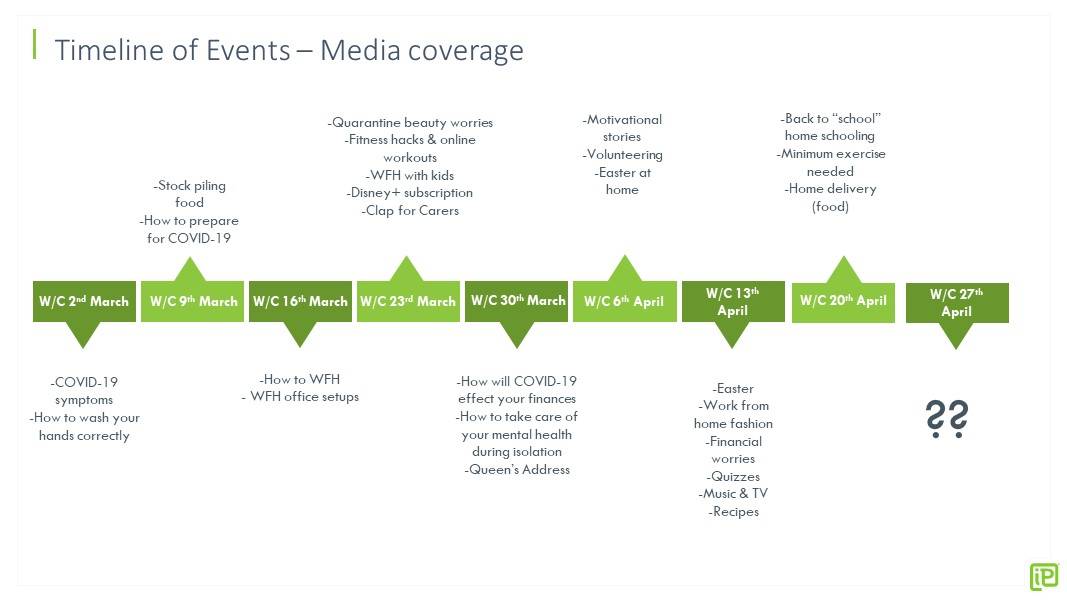The team at iProspect has been monitoring the news agenda since COVID-19 started to have a detrimental impact on the UK. This timeline shows you just how dramatically and quickly things are changing, and how the media conversation is completely aligned to the different stages. You need to be able to ensure your content is more reactive and relevant than ever, because as the world changes, so does the media and consumer landscape.

To tackle this conundrum of what type of content you should be creating during COVID-19 head on, we’ve devised five key considerations for your content and PR teams and strategy.
1 – Monitor to understand
There are a number of ways to go about plotting what content you should be creating:
- Your customers – what questions are you receiving via your customer service team? Make sure your content meets these needs.
- Search listening – what is the current keyword demand for COVID-19 relating to your brand? If you’re a beauty brand, what home tutorials can you provide them? If you’re a bank, how can you assure your customers that their money will be safe in these times?
- Social listening – what are customers saying on social, and how can you create content around that to mitigate fears or concerns?
- Media interest – what is the media talking about? This seems to change on a weekly basis now, but keeping an eye on the news agenda will help you understand what consumers are reading about
- Your competitors – It’s a great opportunity to do competitor spotlighting and ensure you benchmark well against your competitors.
It’s important to note that people’s interest in digital content has increased significantly since COVID-19. Consumers have more time and in the evenings are turning to the web for news, inspiration and humour.
2 – Be flexible to be relevant
The temptation is to pull back on creating content but, right now, your customers need you more than ever. The content you had planned to publish is probably not something customers want right now, but you can audit it, then tweak or refresh it for the new circumstances.
If you look at something like travel insurance, terms relating to that topic usually mean people are looking to take it out for an upcoming holiday. But now the intent of that topic and terms related to that product have changed massively. It’s now all about “Am I covered?”. Your brand needs to adapt to provide customers with content that is useful to their new intent by offering a solution and addresses a fear or concern.
It is very likely your messaging will need to change, across your website, on your social platforms, in your meta descriptions. We have been testing messaging with a few fashion brands and seeing uplift with a softer “We’re here for you” approach in messaging. Try this, test it, change it.
3 – Be easily found
This seems obvious but a consideration that is crucial right now: your content needs to be found. This splits out into two parts:
Website architecture
- Refrain from taking your whole site down, we understand the need to keep parts of the site restricted, but we’ve seen brands take their site down and must suffer the consequences.
- Your website and owned properties need clear navigation to useful content
- Your site must be quick. People have short attention spans at the best of times and what people are demanding right now is answers fast, so you must improve the speed of your site
- Your content needs to be able to be indexed by Google so it can be listed, and customers can find it
- The structure of your page is a hugely important. Think about questions like “How to get Vitamin D in my diet?” or “How to work out at home”. These both trigger a featured snippet in Google, so if you’re a fitness or food brand you can provide genuinely helpful responses to this. However, if the structure of your page hasn’t been set up correctly, you’ll never be featured in position zero
Positive PR
It’s likely that your PR activity is paused, cancelled or postponed, and is now only about crisis management, which is understandable. However, people are looking for positive stories. You’ve only got to put the term “positive stories” into Google Trends to see that people want them right now.

In addition to this, journalists want positive, non-Coronavirus stories:
The media is crying out for content. Remember, most journalists need to be able to produce a new article every 45 minutes, so it’s likely that they’ll run out of COVID-19 stories eventually. What they want is motivating, surprising, useful and positive content for their audiences. Here’s a quote to back this up:
“Positive news stories are a must. Make it personal; social good, wellness, health, etc. let’s not dwell on the bad times. Similarly, if your story isn’t getting pick-up, consider adding an expert or personal angle” – Angelica Malin, Editor-in-Chief, About Time
There is a captive audience out there right now, and PR shouldn’t stop because of COVID-19. There has been a 43% increase in traffic to news sites (since start of March), so the demand is high. If you want your content to be seen by a wider audience, then PR is the best way to do this.
4 – Demonstrate expertise
Google has been quite open about its algorithm and guideline changes over the past couple of years. First, we had E-A-T (Expertise, Authority, Trust) then there was YMYL (Your Money Your Life) and most recently we had BERT (Bidirectional Encoder Representations from Transformers) and actually during COVID-19 all of them take on an even heavier importance.
It’s now that people are looking for a layer of expertise beyond fluffy content. This presents brands with an opportunity to offer customers expert advice, perhaps in the form of employees who have decades of experience in a sector. For example, do you have a beauty consultant who can offer expertise on skincare at home? Do you have a mortgage advisor who has been at your bank for 30 years? If so, can they give their expert opinion? If you’re creating this content, ensure that readers know who the author is. This builds trust between the brand and the reader and is widely encouraged by Google.
Google’s approach to YMYL is that every page you create should impact a customer’s Money or Life. So, think about that in relation to COVID-19. Give your customers content that delivers tips on how to improve their life right now (and for the future) but also make sure you’re giving them solutions for intricate financial decisions.
Lastly, BERT is a deep learning algorithm that understands the nuances and context of words in a sentence, to better match queries with search results. Make sure your content is structurally sound and can be processed by BERT so that it can be visible in Google.
5 – Be critical of your own content
The last consideration for every piece of content, whether it’s on your website, social or in email, is whether it is purposeful or profiteering? If you have an inkling that the content you’re creating doesn’t provide people with purpose or a point, then tweak it so it does. You can absolutely provide customers with products that solve problems and solutions, but don’t piggyback on COVID-19 for the sake of it.
It’s important to not go ‘dark’ and turn the lights off on your marketing activity. If anything, now is the time to make sure you’re connecting with customers. There is an obvious temptation to avoid the topic or in some cases withdraw any content at all, but it’s been proven that brands that don’t cut budgets during periods of uncertainty are best placed to prosper when the upturn returns. Numerous studies have proven this over many years.
Piece adapted from original iProspect article.






